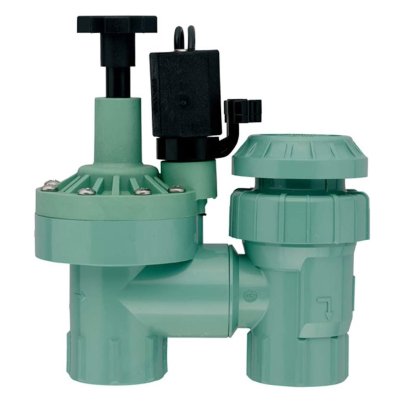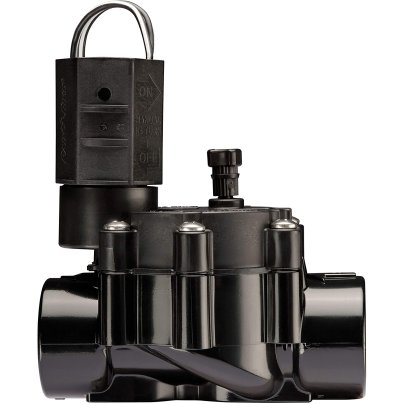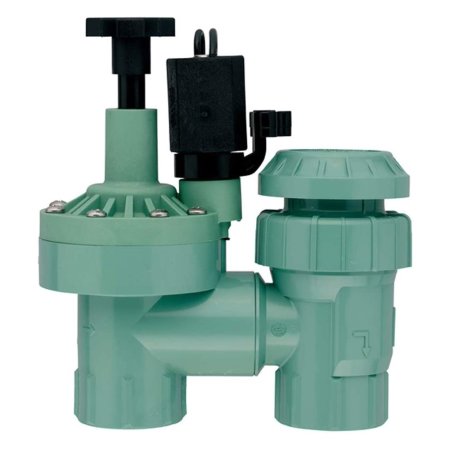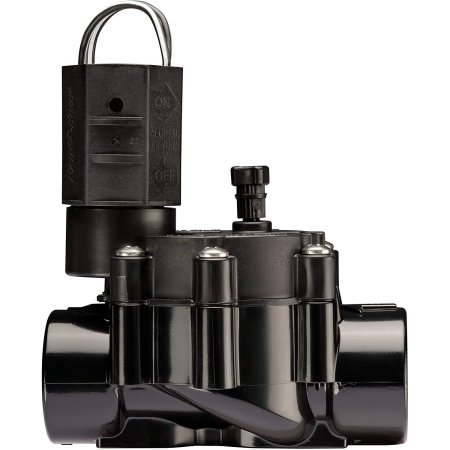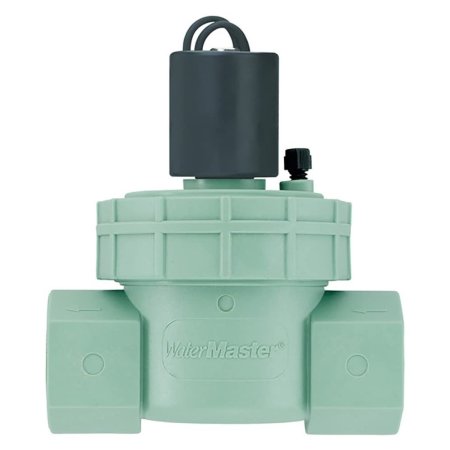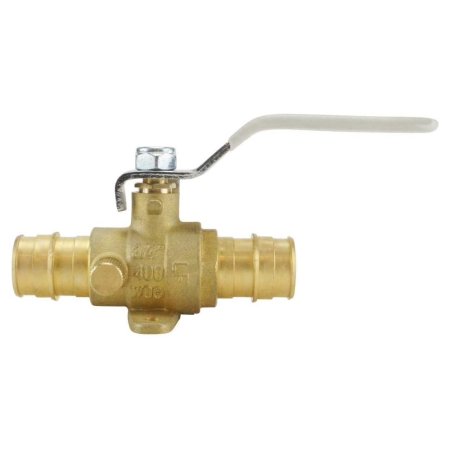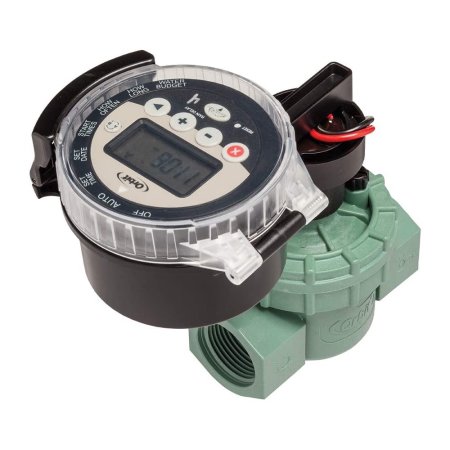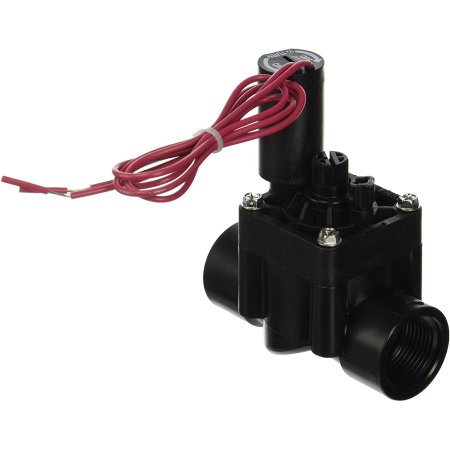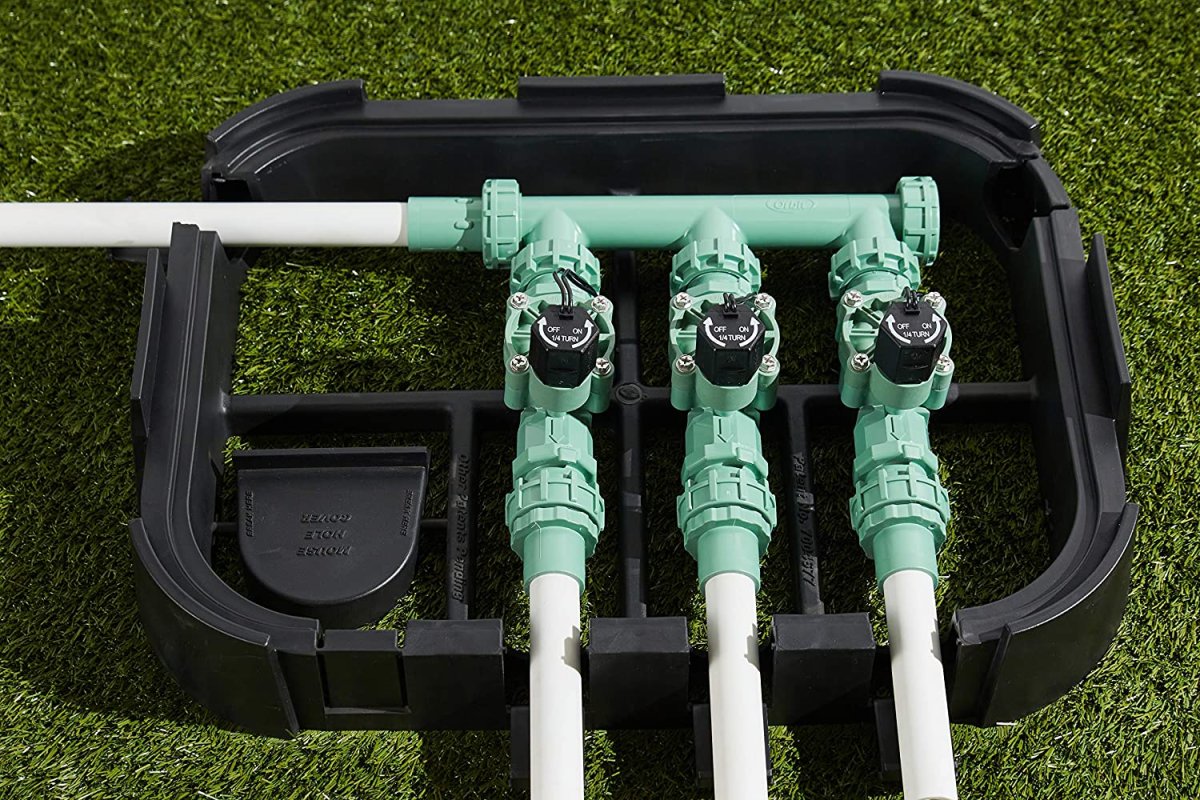
We may earn revenue from the products available on this page and participate in affiliate programs. Learn More ›
Sprinkler systems save time and eliminate the need to pull out a hose to water the yard, but a system’s vital valves, which regulate water flow, don’t last forever. When a sprinkler system valve goes bad, replacing it is a relatively straightforward project.
Despite the variety of options available, sprinkler valves serve one very simple purpose: They regulate water flow. Some turn water on and off, while others restrict the amount of water that flows through a sprinkler system. The way they accomplish this—and the size of the system they serve—varies, but they all perform the same primary task.
When putting in a new sprinkler system, valves are installed based on the brand of the system, and the installer will select the types and sizes suitable for different watering zones. Some sprinkler systems require dozens of valves to control water usage to multiple zones in a yard, while others have only a single on/off valve. Our favorite is the Orbit 57632 3/4 Automatic Anti-Siphon Valves thanks to its valve design and heavy-duty construction.
Ahead, learn what to consider when selecting the best sprinkler valves for a specific sprinkler system, and find out why the following models are all well suited for use in home systems.
- BEST OVERALL: Orbit 57623 ¾ Automatic Anti-Siphon Valves
↓ Jump to Review - BEST BANG FOR THE BUCK: DIG 1/2 in. In-Line Shut-Off Valve
↓ Jump to Review - BEST INLINE VALVE: Rain Bird ¾-Inch FPT In-Line Sprinkler Valve
↓ Jump to Review - BEST VALVE MANIFOLD: Orbit 57253 3-Valve Heavy-Duty Preassembled Manifold
↓ Jump to Review - BEST EASY-ACCESS VALVE: Orbit 57461 Automatic Sprinkler System Jar Top Valve
↓ Jump to Review - BEST BALL VALVE: Apollo ¾-Inch Brass PEX Barb Ball Valve with Drain
↓ Jump to Review - BEST BATTERY-OPERATED: Orbit 57860 Battery-Operated Sprinkler Timer
↓ Jump to Review - BEST GLOBE VALVE: Hunter Sprinkler PGV101G Globe Valve
↓ Jump to Review
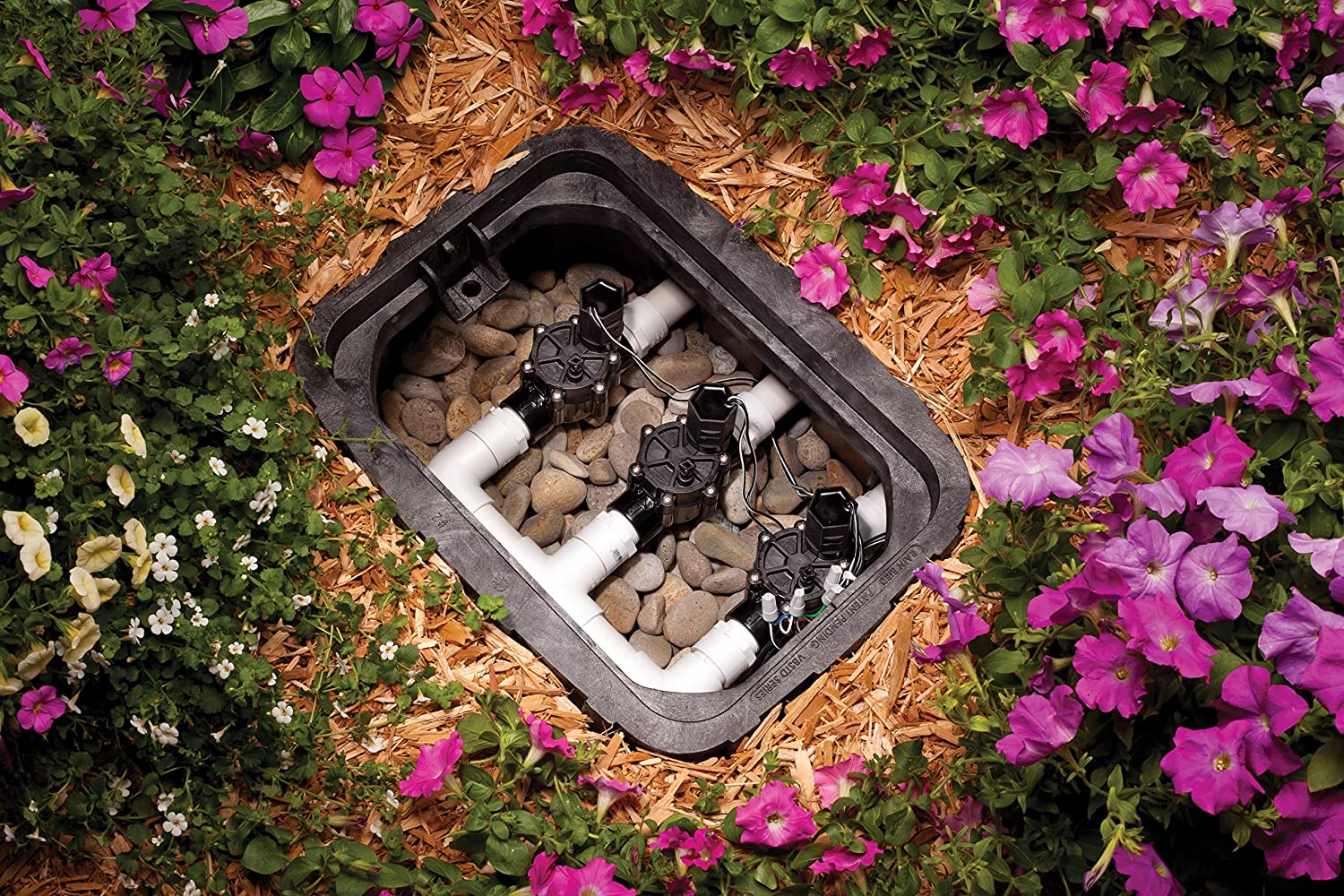
How We Chose the Best Sprinkler Valves
In selecting the sprinkler valves for this lineup, we extensively researched dozens of valves. We weighed their pros and cons and analyzed what type of sprinkler system they were best suited for.
Brand reputation was also a consideration, with Orbit and Rain Bird among the well-known manufacturers with national distribution. However, we didn’t disregard smaller brands, as quality new manufacturers are always worth a look.
We selected models suitable for a range of uses—both for large sprinkler systems with multiple zones and small, aboveground drip and misting systems to offer the broadest range of valves. We also looked at ease of installation and whether the valves would adapt to existing systems.
Our Top Picks
Watering needs vary, and sprinkler systems vary, so it’s only natural that sprinkler valves differ as well. The best sprinkler valve for one watering system may be unsuitable for another. The following sprinkler valves were selected based on how well they fulfill particular water-regulating needs. By replacing any failing valves yourself using one of the products below, you can save money on the cost of a sprinkler repair.
Best Overall
Orbit 57623 ¾ Automatic Anti-Siphon Valves
Product Specs
- Type: Anti-siphon
- Size: ¾ inch
- Pressure rating: 120 pounds per square inch (PSI)
What We Like
- Heavy-duty molded plastic construction
- Valve design prevents backflow
- Water pressure is adjustable to suit sprinkler head
- Compatible with most systems
What We Don’t Like
- Installation may be too complex for a DIYer
For sprinkler systems requiring a designated backflow preventer, consider the Orbit anti-siphon valve. This valve comes in a muted green color that blends in with landscape plants. It features a ¾-inch female threaded inlet connection and a ¾-inch outlet connection. The Orbit sprinkler valve allows water to flow freely from the house to the sprinkler system but prevents water from flowing backward from the system into the house.
The valve installs above the ground and can bleed (drain) the lines for winterizing. Users can adjust the valve’s pressure to suit the type of sprinkler heads used.
Get the Orbit 57623 sprinkler valve at Amazon, Ace Hardware, or The Home Depot.
Best Bang For The Buck
Dig ½-Inch In-Line Shut-Off Valve
Product Specs
- Type: In-line
- Size: ½ inch
- Pressure rating: Up to 60 PSI
What We Like
- More affordable than most shut-off valves
- Design makes it easy to install and operate
- Can regulate water pressure
What We Don’t Like
- Not suitable for high-pressure systems
Regulating water flow in an aboveground sprinkler or drip-type watering system needn’t cost a lot. The Dig in-line shut-off valve connects to ½-inch poly tubing. Both ends of the valve feature push-type barbed connections that simply push into the tubing to form a leak-free seal. This in-line sprinkler shut-off valve is designed for aboveground use and features high-quality UV-resistant PVC.
To operate the DIG valve, simply turn the handle 90 degrees. When the handle lines up with the tubing, the water is on; turning the handle perpendicular to the tubing shuts the water off. The DIG valve can also regulate water pressure by turning just a bit between the on and off positions.
Get the Dig sprinkler valve at The Home Depot or Cheap Sprinklers.
Best Inline Valve
Rain Bird ¾-Inch FPT In-Line Sprinkler Valve
Product Specs
- Type: In-line
- Size: ¾ inch
- Pressure rating: 15 to 150 PSI
What We Like
- Valve can be adjusted manually
- Works with all sprinkler systems
- Built-in flood-preventive feature
What We Don’t Like
- Not for use above ground (not ultraviolet resistant)
Those looking for a high-quality replacement valve for an in-line connection may be quite pleased with the Rain Bird in-line valve. It’s made to replace an existing buried in-line valve that connects to ¾-inch piping.
The Rain Bird valve is a residential and light commercial-grade valve made to install at the same level as underground sprinkler system piping. It’s compatible with all types of system controllers via existing irrigation wiring. The Rain Bird valve may also be adjusted manually to bleed the irrigation lines if desired to winterize the sprinkler system. The valve features both female inlet and outlet connections, and it comes with a unique reverse-flow feature that closes the valve to prevent flooding in the event of a leak.
Get the Rain Bird sprinkler valve at Lowe’s or The Home Depot.
Best Valve Manifold
Orbit 57253 3-Valve Heavy-Duty Preassembled Manifold
Product Specs
- Type: In-line
- Size: Adaptable (¾ or 1 inch)
- Pressure rating: 150 PSI
What We Like
- Connects 3 pipes in 1 valve box
- Only requires a single irrigation wire
- Compatible with most sprinkler systems
What We Don’t Like
- Pricier than other sprinkler valves
Manifolds are used extensively in water supply situations, such as home water distribution centers, and they can be just as beneficial in routing water to various sprinkler zones. The Orbit three-valve manifold lets users connect three different sprinkling system zones in a single buried water sprinkler valve box.
The manifold features female-threaded inlets and outlets and comes with screw-on couplings for either ¾-inch or 1-inch pipes (adapters included). Once the couplings are attached to the existing lines via PVC glue, twisting the screw-on collars to securely attach the pipes is a simple matter. This three-valve Orbit manifold reduces wiring worries, as a single existing irrigation wire is sufficient for controlling all three valves.
Get the Orbit 57253 sprinkler valve at Amazon, Lowe’s, or The Home Depot.
Best Easy-Access Valve
Orbit 57461 Automatic Sprinkler System Jar Top Valve
Product Specs
- Type: In-line
- Size: 1 inch
- Pressure rating: 150 PSI
What We Like
- Screw-off jar top for easy access
- Compatible with most sprinkler systems
- Heavy-duty stainless steel interior components
What We Don’t Like
- Channel lock pliers may be required to remove the jar lid
Should debris become lodged in a sprinkler valve, flushing out the valve with water will often remedy the problem. With some valves, the user must use a wrench or other tools to disassemble the valve for flushing. Not so with the Orbit jar top sprinkler valve, which has a top that twists off by hand, making it simple to access the inside of the valve. The jar-top valve attaches to 1-inch sprinkler system pipes, connects to an existing irrigation wire, and is compatible with most system controllers. It features heavy-duty construction and stainless steel interior components for durability. This Orbit valve has female threaded connections on both the inlet and the outlet. It also features an optional manual bleeding screw for draining and winterizing the lines.
Get the Orbit 57461 sprinkler valve at Amazon, Lowe’s, or The Home Depot.
Best Ball Valve
Apollo ¾-Inch Brass PEX Barb Ball Valve With Drain
Product Specs
- Type: In-line
- Size: ¾ inch
- Pressure rating: Up to 200 PSI
What We Like
- Installs above or below ground
- Easy-to-use manual handle
- Includes drain screw for bleeding lines
What We Don’t Like
- Does not connect to a main controller
Simple in style and purpose, the Apollo Brass PEX barb ball valve offers a way to turn the water supply off and on manually. This makes it handy to use where there’s no existing irrigation wire, and it’s just as suitable for use on an outdoor spigot as it is on buried sprinkler lines. The Apollo valve also comes with a manual drain screw for bleeding the system’s lines, if desired.
This type of control valve features a handle that aligns with the direction of the connecting pipes when the water flow is on and perpendicular to the pipes when the water is turned off, so users know the status of the water at a glance. By turning the handle just slightly, the valve can be used to increase or reduce water flow. The Apollo valve’s inlet and outlet connections fit ¾-inch PEX tubing (but push-type PEX connectors are not included).
Get the Apollo ¾-inch sprinkler valve at The Home Depot.
Best Battery-Operated
Orbit 57860 Battery-Operated Sprinkler Timer
Product Specs
- Type: In-line
- Size: 1 inch
- Pressure rating: Not listed
What We Like
- No irrigation wire needed
- Regulates up to 4 zones
- Removable timer for easy programming
What We Don’t Like
- Batteries will require recharging
When there’s no existing irrigation wire to connect a valve to a central control unit, the Orbit battery-operated valve steps up. This valve, which operates on three AAA rechargeable batteries (not included), serves as its own control unit, making it well suited to replace manual valves or install a sprinkler system with no access to electricity. It’s designed for in-line, underground installation.
This Orbit valve features a digital LED readout and can regulate up to four separate sprinkler zones. Users can choose from eight preset start times, and the valve can be programmed to water at any time for up to 4 hours. Entire watering programs can be preset for up to 30 days. The timer detaches from the housing for easy programming. The valve features two threaded female outlets and is designed for a 1-inch pipe.
Get the Orbit 57860 sprinkler valve at Amazon or Lowe’s.
Best Globe Valve
Hunter Sprinkler PGV101G Globe Valve
Product Specs
- Type: In-line
- Size: 1 inch
- Pressure rating: 20 to 150 PSI
What We Like
- Made from durable materials
- Compatible with most sprinkler systems
- Easy-flush debris removal option
What We Don’t Like
- Not made for aboveground use
Those who may want to decrease the water flow to a specific zone should consider the Hunter sprinkler globe valve. It’s designed to damper down water flow for lighter-usage sprinkler heads, such as bubblers or misters. This in-line sprinkler valve connects to most sprinkler systems via an existing irrigation wire.
The valve is built to last, made from high-grade materials, and it comes with one-screw debris removal that makes it easy to flush. The Hunter valve is designed to connect to buried sprinkler system lines in a sprinkler valve box. It attaches to a 1-inch pipe via two female-threaded connections—both inlet and outlet.
Get the Hunter sprinkler valve at Amazon, Lowe’s, or The Home Depot.
Jump to Our Top Picks
What to Consider When Choosing a Sprinkler Valve
If you’re shopping for the best sprinkler valve, it will usually be to replace one that’s broken or stopped working effectively. The best course of action is to remove the valve in question and take it to a plumbing supply store to get a suitable replacement. The best sprinkler valves will vary from system to system based on type, the amount of water flow, and pipe size.
We tapped Tom Smith, general manager and owner of Desert Designer Landscape and Development in Phoenix, Arizona, for more insight on how to choose sprinkler valves.
Types of Sprinkler Valves
Residential sprinkler systems are straightforward setups that need four main components to operate: a water source, piping, sprinkler valves, and sprinkler heads. Many systems, but not all, also feature a main control unit with a programmable timer that acts as the system’s brains and communicates with the valves (via an irrigation wire) to disperse water to different areas of the yard. The two main types of sprinkler valves are in-line and anti-siphon. Different options are available within those two types, but most valves are in-line valves.
- In-line: Most in-line valves are located below ground in a valve box that protects them from dirt and offers a bit of insulation from cold weather. These valves are installed at the same level as the buried sprinkler water lines, hence their “in-line” designation. In-line valves do not prevent the flow of water backward, so the sprinkler system will also need a separate backflow preventer to protect the home’s drinking water.
- Anti-siphon: While in-line valves are usually buried, anti-siphon valves, also called backflow preventer valves, are installed above ground. They serve to prevent the sprinkler system’s dirty water from flowing backward into the home’s drinking water supply. The best anti-siphon sprinkler irrigation valve is easy to access and made from high-quality materials.
The best type of valve for a specific sprinkler system will depend on local codes. Some communities require anti-siphon valves, which are easy to test because they’re located above ground, while others permit in-line valves and separate backflow preventers.
Automatic Control Sprinkler Valves
Unless a sprinkler system or irrigation system is entirely manual—meaning the user turns it on and off by hand—the valves in the system will be automatic, usually via a central control unit. During installation, irrigation wires are run in the same trenches as the pipes: one wire from the control unit to each of the valves. The low level of electricity in the wires (22 to 28 volts) is sufficient to turn the valves on and off.
Alternatively, irrigation system valves may be battery operated, in which case they often serve as simple timers that can be programmed to run a limited number of watering zones. These are often in-line valves that attach to buried lines but are still accessible within a protective box.
Gate Valves
A gate valve is a barrier that prevents or allows water flow. These devices have been around for decades, and the best manual example is the knob on an outdoor faucet, called a sillcock. Turn the knob clockwise and the motion lowers a gate within the faucet that cuts off the water flow. Turn the knob counterclockwise, the internal gate lifts, and the water flows freely. Large gate valves can be found in municipal or agricultural water systems where they serve the same purpose of turning on or off the water flow.
Ball Sprinkler Valves
A ball sprinkler valve is a manual valve used to turn the water on and off to separate parts of an irrigation or sprinkler system. A ball valve is an in-line irrigation control valve with a straight handle that controls a ball within the valve that either permits water flow or blocks it. The handle moves only 90 degrees: when the handle is aligned in the direction of the pipe, the water is on; when the handle is turned 90 degrees perpendicular to the pipe, the water is off.
Check Valves
Check valves are simple in-line valves that prevent water backflow. Like anti-siphon valves, they keep contaminated water from the sprinkler system from seeping backward into the home’s water supply. They’re frequently used on pipes that supply water to pumps, pools, and sometimes sprinkler systems. Depending on local codes, however, a simple check valve may not be considered adequate to protect the drinking water in the home. In some communities, a designated anti-siphon valve may also be necessary.
Globe, Angle, and Indexing Valves
Less common types of valves may also be found in some sprinkler systems.
- Globe valve: Similar to a gate valve, a globe valve has a round knob that regulates water flow. The difference is that a globe valve is better suited to adjusting water pressure, while a gate valve can only stop or start water flow, not regulate it. Globe valves can be manual or run on electricity.
- Angle valve: Known as an angle valve due to connecting pipes at a 90-degree angle, this type of valve is most commonly found inside a home where water supply lines connect at various angles. It is most often a manual valve.
- Indexing valve: A component in manual sprinkler systems, indexing valves operate not on electricity but instead on water pressure. As water flows through the valve, an internal wheel (imagine a water wheel) gradually turns, opening the flow to different watering zones while blocking flow to others.
Size
Valves are sized to fit specific pipe diameters. When replacing a ¾-inch valve, you’ll need to purchase another ¾-inch valve.
“Most residential jobs will have a ¾-inch system,” Smith says. “If you have a larger job, there are larger valves. Commercial valves can go up to 2 or 3 inches, but most residential valves will be ¾ inch.”
Water Flow
The amount of water that flows through the piping is measured in gallons per minute (GPM) or gallons per hour (GPH), which indicates how much water is available. Water flow depends mainly on pipe diameter. Pipes measuring ¾ inch in diameter will typically support approximately up to 8 GPM of water flow, depending on the quality of the valve. For larger sprinkler systems with flow rates greater than 12 GPM, 1-inch pipes and valves are more common.
Maximum Pressure
Water flow and water pressure are related yet slightly different. The force of the water per square inch (psi) determines the type of sprinklers used. During installation, the installer will determine the optimal amount of water pressure for a specific zone in the yard. Powerful rotor-type sprinklers require more water pressure to operate than do bubblers or drip-type nozzles that are commonly found in flower beds.
“Most cities control the water pressure coming out of their water system, so if you live within city limits, you probably don’t have to worry about water pressure,” Smith says. “However, if your water pressure is too high, you will need to install a pressure regulator in your irrigation system.”
Connection and Compatibility
The main rule when choosing sprinkler valves is to select a valve with the same type of connections as the previous valve. For example, suppose the existing valve had the typical configuration of both a female-threaded inlet and a female-threaded outlet. In that case, choose a new valve with similar threaded connections. If that’s not possible due to a limited selection of valves, adapters are usually available to make the connections fit.
Fortunately, most sprinkler valves are universal, meaning one valve brand will replace another brand, as long as the size and other factors match.
“You can use whatever brand of valve you want,” Smith says. “It just needs to be the same size as your previous valve.”
Automatic or Manual
Most installed sprinkler systems feature automatic valves that work with the central control unit. However, manual systems are still in use and are well suited to aboveground misting and drip irrigation systems that the gardener can turn on and off by hand as desired. Manual valves are not suitable for an automatic system and vice versa.
Automatic valves feature a solenoid: a coiled wire component that acts as an electromagnet to turn the valves on and off. Automatic valves must connect to a buried irrigation wire or be battery operated.
Durability
Valves are available in a variety of materials. Copper, galvanized metal, and stainless steel are among the most durable options, but they’re also pricier. An inexpensive plastic shut-off valve will fit the bill for those who want to install a simple drip system.
“Most valves are PVC; there are metal valves, but we almost always work with PVC for residential,” Smith says. “Metal valves are more of a commercial thing.” He says to be prepared to replace valves every 6 or 7 years, which may add to your sprinkler repair cost.
FAQs
Sprinkler systems are a boon for helping water the lawn and landscape uniformly, but sprinkler valves don’t last forever. When one goes on the fritz, little or no water may come out of the sprinkler heads, or water may gush from a cracked valve. Some questions are likely for those seeking to replace worn or damaged valves.
A sprinkler valve regulates the flow of water. Some valves communicate via a buried irrigation wire with a central control unit that turns them on and off according to a program, while others are battery operated. Some are entirely manual, and still others utilize the force of water moving through the valve to control water flow.
When a valve goes bad, sprinkler heads may emit weak streams of water—or no water at all. Dampness or sponginess may be noticeable around a sprinkler valve box if the valve is broken and leaking.
Depending on the type, a single replacement valve costs between about $4 and $65, while the best sprinkler manifold can cost up to $100 or more. While some systems use valves that are fairly simple for a DIYer to install, professional installation.
In general, the best irrigation valves last 5 to 10 years before needing replacement.
If the sprinkler heads are not watering as they should be, open the valve box and look for flooding. If the valve is not leaking and is connected to an irrigation wire, use a voltmeter to test the voltage at both the valve and the central control unit. The sprinkler valve solenoid (the component that connects to the irrigation wire) should test between 24 and 28 volts.
Yes, each watering zone needs a separate valve.
Debris, such as sand or dirt, can get stuck in a valve and keep it from closing.
Eventually, yes, but most will last 5 to 10 years, depending on quality.
